Great Bee Day 2025: You too can help pollinators
Learn about bee secrets and see why you should protect these black and yellow insects.


Learn more about our editorial process
.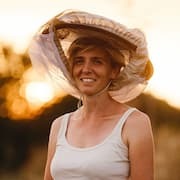

Learn more about our editorial process
.

Learn more about our editorial process
.

Learn more about our editorial process
.
Why you can trust us
Articles on Natu.Care are written based on scientific research, data from government websites and other reliable sources. The texts are written in cooperation with doctors, nutritionists and other health and beauty experts. Articles are reviewed before publication and during significant updates.
.Learn more about our editorial process
.Information about advertisements
Content on Natu.Care may contain links to products from the sale of which we may receive a commission. When creating content, we adhere to high editorial standards and take care to be objective about the products discussed. The presence of affiliate links is not dictated by our partners, and we select the products we review ourselves completely independently.
.Learn more about our terms and Conditions
.Without them, you wouldn't eat a tomato sandwich and leave half your paycheck at the meat counter. honey they save the world from famine every day. You read that right starvation, not honey.
This is not an exaggeration. It is estimated that about ⅓ of the world's food is produced by bees and other pollinators. As many as ¾ of crops would not exist without these insects - we would have to say goodbye to most vegetables and fruits.
Although the honeybee population has been increasing in recent years, it is still too early to be optimistic. The striped hive dwellers still need protection. The good news is that you can help them too.
The good news is that you can help them too.
From this article you will learn:
- Why bees are great.
- Why bees are great.
- What is the situation of beekeeping in Poland. .
- How bees feed the world (and what they have to do with meat). .
- Who else in the insect family is a brave pollinator. .
- What you can do for bees. .
See also:
- Clean Air Day .
- Fish Day
- World No Mobile Phone Day
- National Kindergarten Day
- World Blood Donor Day
- Bone Marrow Donor Day
- Lung health after the pandemic
- Hug Day
- Of singles on Valentine's Day
When is Bee Day?
.In Poland, bees have as many as two holidays: on 20 May, together with the whole globe, we celebrate World Bee Day. But in the comfort of our Polish apiaries we still celebrate Great Bee Day, which falls on 8 August. This year marks the eleventh time it has been celebrated. Join in!
Meet the heroes
.Bees are hymenopterous insects from the group of stingers. Wasps can also be classified in a similar way - necessarily these insects are quite similar to each other. However, one thing that distinguishes them is what they eat. Wasps, although also able to feed on nectar, are mainly carnivorous. They are efficient hunters who also do not despise carrion. Bees, on the other hand, have converted completely to vegetarianism.
.The honeybee is one of the species of bees living in Poland, and is a pollinator and pollinating insect. In contrast, it is not a wild bee, but a farm animal..
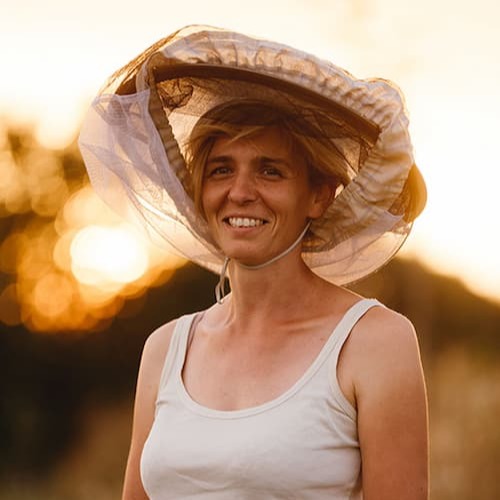 .
.
Agneska Dukat-Pokrywa beekeeper from Apiary on the Shore
The plant-based diet has influenced the appearance of honey bees - the distinctive feather helps them to collect pollen, which easily attaches to it. Unlike wasps, they are peaceful by nature and reluctant to sting - it is their last resort. They use it mainly to defend the colony.
Some internal organs are attached to the bee stinger. After a sting, the bee's stinger stays in the skin and with it some of its organs, which is fatal to the bee itself. It is different with wasps, which can sting repeatedly without unpleasant consequences for themselves.
Interesting fact
Virtually all bees feed on plant food. However, there is a type of bee Trigona whose representatives feed on carrion. Fortunately, you will not encounter them in Poland. Trigona necrophaga, or vulture bee, has no stinger, but the most amazing thing is that it can produce honey from carrionand.
.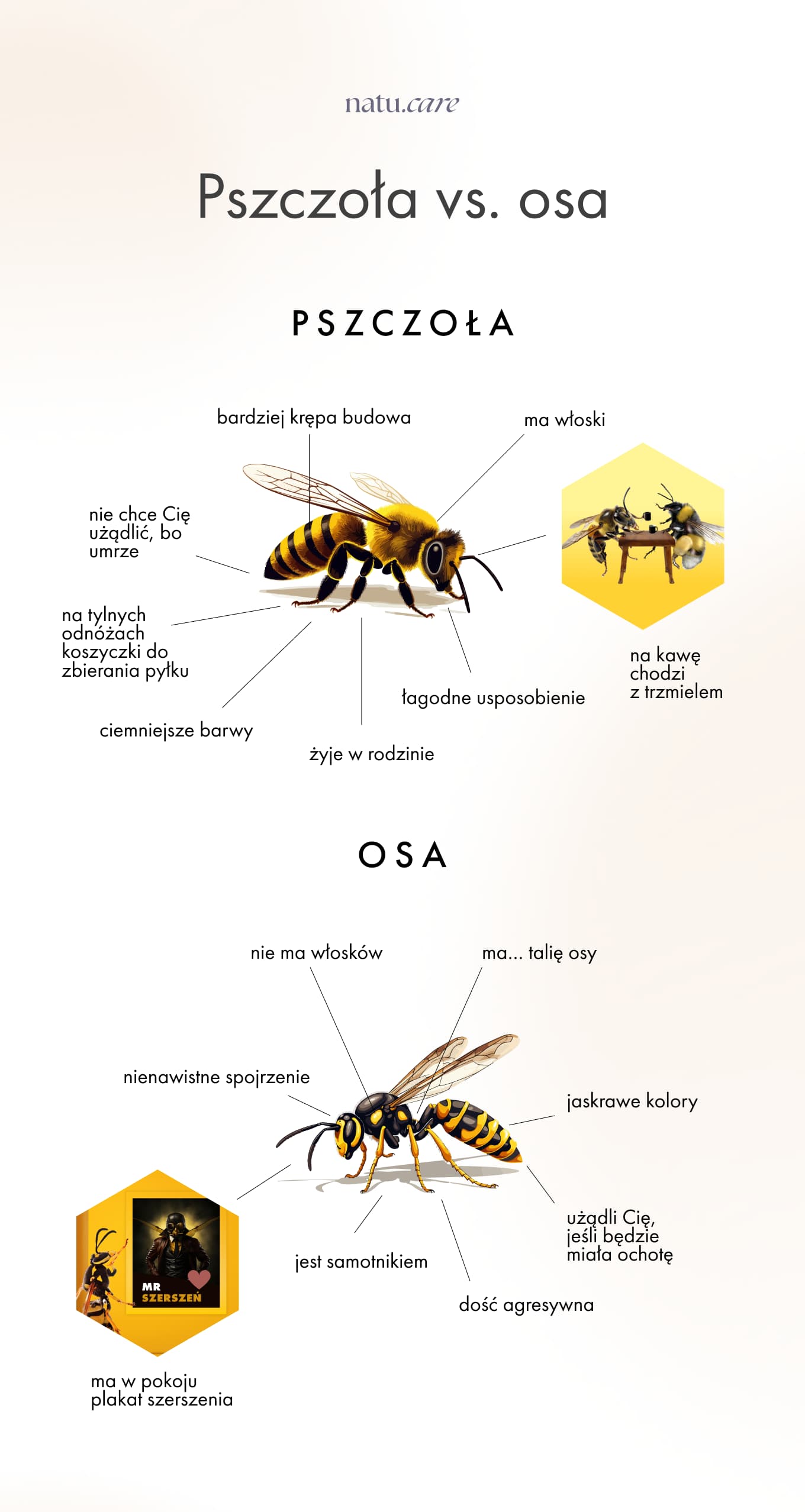
Interesting fact
.Bees cannot see the colour red. Instead, they see in the ultraviolet spectrum, which we are unable to seeand.
Bee habits
.Honey bees are family creatures. Their single stock originating from a single queen-mother is called a bee family. If you're sometimes up to your eyeballs in siblings or cousins, consider that a honeybee has to cope with relatives ranging from 20 to as many as 120,000and.
The number of bees in a hive depends on the time of year - during the summer, when the queen lays her eggs (broods) the bees are at their highest number. However, at the end of August, the breeding season ends, and the drones (male bees) are driven from the nest because they have done their joband.
The bee family has a strict hierarchy and can be said to have a caste system. At the top is the queen, who is the only one who can reproduce and is generally the mother of all worker bees. Well, there is only one mother...
.The next group are the drones. They are generally concerned with eating and... fertilisation. On the surface, their life seems idyllic, but as soon as autumn comes, the queen stops brooding and the men become useless. The worker bees brutally drive them from the nest or kill themand.
Bees die after the bee queen is fertilised..

Agneska Dukat-Pokrywa beekeeper from Apiary on the Shore
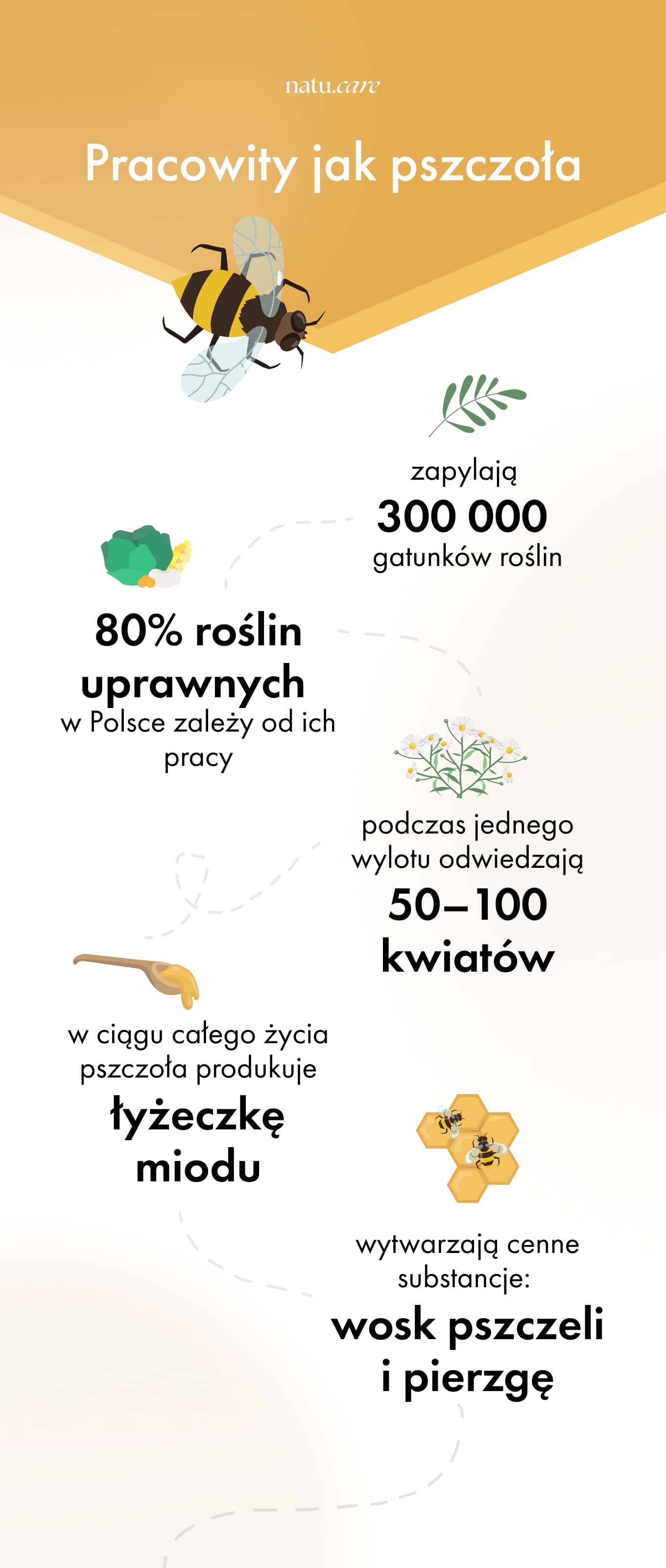
Since I mentioned worker bees: they are the most numerous group in a bee colony. What role a worker bee plays depends on its ageand. The youngest ones keep the hive clean and tidy. The slightly older ones take care of the larvae.
Some bees that are about a week old have glands that produce a substance called royal jelly. This is the food of the queen and the drones. When the bees are about two weeks old, they re-brand themselves as builders. They are the ones who build the characteristic patches of beeswax.
Wee bees sweat out wax with special wax glands located on the underside of the abdomen.
 .
.
Agneska Dukat-Pokrywa beekeeper from Apiary on the Shore
In older, three-week-old bees, they develop venom and a stinger. They then become guardians, defending the hive from intruders and honey amateurs. You have to hand it to them that they do this with complete dedication (anyone who, like me, has ever come across a wild bee nest knows).
The oldest and oldest bees.
The oldest and most experienced bees collect nectar, honeydew, pollen and water. They thus provide the food necessary for the survival of the hive. And they are the ones we encounter most often.
The oldest gatherers fly for water, as this is the most dangerous task..
 .
.
Agneska Dukat-Pokrywa beekeeper from Apiary on the Shore
Interesting fact
.A honeybee is estimated to fly up to 800 km in its lifetime! The average lifespan of a worker bee is just 5-6 weeks.
Natu.Care Collagen Premium 5000 mg, mango & passion fruit

- Collagen content: 5000 mg marine collagen hydrolysate
- Additional active ingredients: vitamin C, low molecular weight hyaluronic acid (and L-theanine and coenzyme Q10 in cocoa flavoured collagen or vitamin A and vitamin E in mango–passion fruit flavoured collagen)
- Form: powder sachets
- Dose: 1 sachet per day
- Sufficient for: 30 days
Product description
Fish collagen from the Natu.Care brand in a dose of 5000 mg, based on certified ingredients of the best quality. Regular supplementation will positively influence the appearance of the skinóry, hairów and nails – they will be rebuilt and strengthened from the inside.
In addition to collagen, which is valuable for health and beauty, it also offers other active ingredients that help to maintain a youthful complexion, shiny hair and strong nails.
The formula contains a sufficient portion of the active ingredient to positively affect joints, the musculoskeletal system and immunity.
Natu.Care Premium Collagen is available in two flavours – Cacao Bloom and Rise&Shine. Both formulas are based on the following active ingredients: marine collagen hydrolysate, wild roseóbud extract and hyaluronic acid.
Additionally, Cacao Bloom contains natural L-theanine, coenzyme Q10 and defatted Dutch cacao. Rise&Shine instead contains vitamin E and vitamin A.
These are the best collagens in the world.
These best fish collagens on the market also rós taste – Cacao Bloom is a treat for chocolate lovers. Rise&Shine will appeal to those whoólike the refreshing taste of mangoófruit and passion fruit.
Pros and cons
Pros:
- Vitamin C supports the body's collagen production, enhancing its effectiveness.
- An effective dose of hyaluronic acid, which additionally supports skin hydration and joint health.
- Fish collagen absorbs 50% better. Additionally, the manufacturer specifies the fish species it is sourced from (Atlantic cod).
- The composition has been tested by the independent and accredited J.S. Hamilton laboratory.
- MSC (Marine Stewardship Council) quality certification, which confirms that the collagen source supports sustainable fishing practices.
Cons:
- None.
Additional information
Natu.Care's fish collagen receives praise for its delicious taste. You won't find the fishy aftertaste that often comes through in other collagens. Plus, you have two tasty flavors to choose from: cocoa and mango-passionfruit.
Active ingredients like coenzyme Q10, hyaluronic acid, and natural L-theanine provide anti-inflammatory and antioxidant benefits while slowing down aging processes.
User review
Super, after about 6 weeks of use, the skin on my face became noticeably firmer. Wonderful taste.
Ania ZalewskaNatu.Care customer
Natu.Care Premium collagen 10 000 mg, mango-maracuja

- Collagen content: 10,000 mg marine collagen hydrolysate
- Additional active ingredients: vitamin C, low molecular weight hyaluronic acid (and L-theanine and coenzyme Q10 in cocoa flavoured collagen or vitamin A and vitamin E in mango–passion fruit flavoured collagen)
- Form: powder sachets
- Dose: 1 sachet per day
- Sufficient for: 30 days
Product description
One of the strongest collagens on the market, whichós provides as much as 10,000 mg in a daily serving. This allows the formula to effectively support the condition of the skin, hair and nails.
With this supplement, you will support your beauty, which will allow you to visually stop the ageing process and feel a second youth!
Natu.Care Collagen Premium 10 000 mg comes in two flavours – cherry and mango-maracuja. Both formulas have the same product backbone – collagen, hyaluronic acid and vitamin C.
In the cherry version you additionally find glucosamine, chondroitin and Indian frankincense resin extract. Mango-maracuja, on the other hand, contains vitamin E and vitamin A.
Pros and cons
Pros:
- Tested collagen formula – SeaGarden, whose effects have been confirmed in clinical studies.
- Effective dose of hyaluronic acid, additionally moisturizing the skin and positively impacting joint health.
- Vitamin C supports the body’s natural collagen production.
- The composition has been tested by the independent and accredited J.S. Hamilton laboratory.
- The product has an MSC (Marine Stewardship Council) quality certification – the collagen source supports sustainable fishing practices.
Cons:
- None.
Additional information
Users praise Natu.Care Collagen Premium for the easy dissolvability of the powder.
User review
I noticed a significant improvement in my skin texture after a few weeks of taking collagen regularly. My complexion is now as soft as velvet!
Natu.Care Collagen Premium 10000 mg, cherry

- Collagen content: 10,000 mg of hydrolyzed bovine collagen
- Additional active ingredients: vitamin C, low molecular weight hyaluronic acid, glucosamine, chondroitin, extract of Indian frankincense resin (boswellia serrata)
- Form: powder sachets for drinking
- Serving: 1 sachet per day
- Lasts for: 30 days
Product description
One of the strongest collagens on the market, providing as much as 10,000 mg per daily serving. This product can effectively support the condition of joints, skin, hair, and nails.
With this supplement, you will support your skeletal and joint system as well as your beauty, helping you visually halt the aging process and feel rejuvenated!
Pros and cons
Pros:
- The daily portion of collagen is very large – as much as 10,000 mg.
- Proven collagen formula – COLLinstant, whose effectiveness has been confirmed in clinical studies.
- Effective dose of hyaluronic acid, which additionally moisturizes the skin and positively affects joint health.
- Vitamin C supports the body's natural collagen production.
- Glucosamine is a fundamental building block of compounds found in joint cartilage and a component of collagen that gives elasticity to connective tissue in tendons.
- Chondroitin is a natural component found in the human body, mainly in cartilage. This large molecule (mucopolysaccharide) has the ability to absorb water, which helps maintain the elasticity and resilience of cartilage.
- Frankincense resin extract supports blood circulation and joint mobility and reduces their stiffness. It may help alleviate inflammatory conditions.
- The composition has been tested by the independent and accredited J.S. Hamilton laboratory.
Cons:
- None.
Additional information
Users praise Natu.Care Collagen Premium for the easy dissolving of the powder.
Premium Sodium Butyrate
Product description
Premium Sodium Butyrate is a natural support for your digestive system. With a high dose of butyric acid (940 mg), it supports the regeneration of the intestinal mucosa, improving gut health and function, and aids in the absorption of nutrients. By taking care of your intestines, you're taking care of the health of your entire body.
Studies involving people suffering from irritable bowel syndrome confirm that sodium butyrate is ideal for supporting issues related to bacterial flora imbalances (for example, after antibiotic therapy), constipation and diarrhea, inflammation of the intestinal mucosa, or a diet low in fiber.
Premium Sodium Butyrate capsules are made using the innovative DRcaps® technology. This guarantees that the active ingredients in the product are protected from the destructive effects of stomach acids and digestive enzymes. As a result, we can be sure that the beneficial ingredients are released in the small intestine and are fully absorbed by our body.
Premium Sodium Butyrate from Natu Care is 100% tested, and its composition contains only the highest quality raw materials.
Pros and cons
Pros:
- Supports digestive system function
- Helpful for various gastrointestinal conditions, including IBS
- High dose of butyric acid in each capsule
- Eco-friendly, clean, and tested composition
- Free from added sugar, gluten, GMOs, and lactose
- Innovative capsule technology - DRcaps
Cons:
- None
Additional Information
Take 3 capsules daily at any time of the day, preferably with a meal. Swallow the capsules whole with water.
Premium Sodium Butyrate is intended for adults.
The product should be used under medical supervision.
User review
I've been using the product for 2 weeks. My stomach feels lighter, and my digestion has improved. I recommend it.
Natu.Care Premium Magnesium + Vitamin B6

- Magnesium content per day: 305 mg
- Additional active ingredients: Vitamin B6 (2.1 mg)
- Form: capsules
- Serving size: 3 capsules per day
- Sufficient for: 30 days
Product description
The Premium Magnesium + Vitamin B6 dietary supplement is a comprehensive product that combines three organic forms of magnesium (citrate, malate, and diglycinate) and vitamin B6 in highly absorbable forms.
Magnesium is an essential mineral without which our bodies cannot function properly. It supports the immune, nervous, and muscular systems, maintains electrolyte balance, and is involved in cell division and the regulation of mental functions.
Research shows that magnesium supplementation is even more effective when accompanied by vitamin B6, which is included in our product. Vitamin B6 is responsible for the proper functioning of the nervous and immune systems, as well as the proper functioning of the heart.
If you want to safely get rid of feelings of fatigue, concentration problems, hair loss, muscle cramps, trembling, or irritability, reach for Premium Magnesium from Natu.Care, tested by the independent, certified laboratory J.S. Hamilton Poland.
Pros and cons
Pros
- Supports the proper functioning of the nervous and immune systems.
- Reduces feelings of fatigue and tiredness.
- Maintains proper psychological functions.
- The purity of the ingredients (free from anti-caking agents, artificial fillers, and additives such as titanium dioxide, microcrystalline cellulose, talc, magnesium stearate, and silicon dioxide) has been confirmed by laboratory tests.
- High absorption of ingredients.
- Soft capsules that are easy to swallow.
- Suitable for vegetarians and vegans.
Cons
- None.
Additional information
Take with a meal, 3 capsules per day.
The capsules should be taken with at least 250 ml of water.
If you have trouble sleeping, it is advisable to take 1 capsule in the morning and 2 capsules in the evening, no later than 4 hours before bedtime.
Avoid combining with products high in calcium (milk, yogurt, cheese), as this may negatively affect magnesium absorption.
Pregnant and breastfeeding women should consult a doctor before starting supplementation.
User review
I’m very impressed with the speed of delivery. The product itself is of high quality and absorbs well. After two weeks of supplementation, I’ve noticed a significant improvement in muscle recovery, especially during periods of intense training. I highly recommend it!
Product description
The dietary supplement contains omega-3ᵀᴳ, or omega-3 acids in the form of trójglyceridesów. Scientific studies suggest that this form of fatty acidsós up to 2 times better absorbed than the estersós present in many dietary supplements on the market. This means that you are assured of their effectiveness and of supplying yourself with valuable omega acids.
Fatty acids omega-3 are derived from wild anchovy oil. It is a rich source of healthy fats that are essential for the health of the cardiovascular, immune and nervous systems, as well as the proper function of vision, joints muscles.
Scientific research suggests that wild anchovies are a good source of healthy fats.
Scientific research also suggests that an adequate intake of omega-3 fatty acidsós protects against and supports the treatment of depression and anxiety disorders. In addition, omega-3s influence the hydration and appearance of the skinóry and support healthy sleep.
.
The formula contains a total of 750 mg of EPA+DHA acidsós, which is three times higher than the recommended minimum of 250 mg for the Polish population. Omega-3 TG Premium has studies indicating that its TOTOX is 9, which is a very good result.
Supplementation of omega-3 fatty acidsóis recommended for anyone who does not eat 1–2 portions (approximately 300 g) of oily fish per week. Children during growth, seniors, physically active people, vegans and vegetarians, as well as patients undergoing cardiovascular treatment and prevention of heart disease also have an increased need.
Pros and cons
The dietary supplement contains omega-3ᵀᴳ, or omega-3 acids in the form of trójglyceridesów. Scientific studies suggest that this form of fatty acidsós up to 2 times better absorbed than the estersós present in many dietary supplements on the market. This means that you are assured of their effectiveness and of supplying yourself with valuable omega acids.
Fatty acids omega-3 are derived from wild anchovy oil. It is a rich source of healthy fats that are essential for the health of the cardiovascular, immune and nervous systems, as well as the proper function of vision, joints muscles.
Scientific research suggests that wild anchovies are a good source of healthy fats.
Scientific research also suggests that an adequate intake of omega-3 fatty acidsós protects against and supports the treatment of depression and anxiety disorders. In addition, omega-3s influence the hydration and appearance of the skinóry and support healthy sleep.
.
The formula contains a total of 750 mg of EPA+DHA acidsós, which is three times higher than the recommended minimum of 250 mg for the Polish population. Omega-3 TG Premium has studies indicating that its TOTOX is 9, which is a very good result.
Supplementation of omega-3 fatty acidsóis recommended for anyone who does not eat 1–2 portions (approximately 300 g) of oily fish per week. Children during growth, seniors, physically active people, vegans and vegetarians, as well as patients undergoing cardiovascular treatment and prevention of heart disease also have an increased need.
Additional information
The dietary supplement contains omega-3ᵀᴳ, or omega-3 acids in the form of trójglyceridesów. Scientific studies suggest that this form of fatty acidsós up to 2 times better absorbed than the estersós present in many dietary supplements on the market. This means that you are assured of their effectiveness and of supplying yourself with valuable omega acids.
Fatty acids omega-3 are derived from wild anchovy oil. It is a rich source of healthy fats that are essential for the health of the cardiovascular, immune and nervous systems, as well as the proper function of vision, joints muscles.
Scientific research suggests that wild anchovies are a good source of healthy fats.
Scientific research also suggests that an adequate intake of omega-3 fatty acidsós protects against and supports the treatment of depression and anxiety disorders. In addition, omega-3s influence the hydration and appearance of the skinóry and support healthy sleep.
.
The formula contains a total of 750 mg of EPA+DHA acidsós, which is three times higher than the recommended minimum of 250 mg for the Polish population. Omega-3 TG Premium has studies indicating that its TOTOX is 9, which is a very good result.
Supplementation of omega-3 fatty acidsóis recommended for anyone who does not eat 1–2 portions (approximately 300 g) of oily fish per week. Children during growth, seniors, physically active people, vegans and vegetarians, as well as patients undergoing cardiovascular treatment and prevention of heart disease also have an increased need.
Expert opinion
The dietary supplement contains omega-3ᵀᴳ, or omega-3 acids in the form of trójglyceridesów. Scientific studies suggest that this form of fatty acidsós up to 2 times better absorbed than the estersós present in many dietary supplements on the market. This means that you are assured of their effectiveness and of supplying yourself with valuable omega acids.
Fatty acids omega-3 are derived from wild anchovy oil. It is a rich source of healthy fats that are essential for the health of the cardiovascular, immune and nervous systems, as well as the proper function of vision, joints muscles.
Scientific research suggests that wild anchovies are a good source of healthy fats.
Scientific research also suggests that an adequate intake of omega-3 fatty acidsós protects against and supports the treatment of depression and anxiety disorders. In addition, omega-3s influence the hydration and appearance of the skinóry and support healthy sleep.
.
The formula contains a total of 750 mg of EPA+DHA acidsós, which is three times higher than the recommended minimum of 250 mg for the Polish population. Omega-3 TG Premium has studies indicating that its TOTOX is 9, which is a very good result.
Supplementation of omega-3 fatty acidsóis recommended for anyone who does not eat 1–2 portions (approximately 300 g) of oily fish per week. Children during growth, seniors, physically active people, vegans and vegetarians, as well as patients undergoing cardiovascular treatment and prevention of heart disease also have an increased need.
Natu.Care Vitamin D 2000 UI
Product description
Vitamin D plays a crucial role in our health and well-being. It affects calcium and phosphate metabolism, which translates to healthy bones and teeth. It also helps regulate the immune system, and studies indicate its influence on the functioning of the nervous system.
Vitamin D, although called a “vitamin,” is actually a prohormone that our body produces on its own, primarily under the influence of sunlight. Unfortunately, our modern lifestyle contributes to deficiencies of this essential vitamin. Working in enclosed office buildings, using (necessary!) SPF creams, and covering the body with clothing all make it very difficult, if not impossible, to obtain adequate levels of vitamin D from sunlight. This is why appropriate, year-round supplementation is so crucial.
Vitamin D from Natu.Care is a well-tested vitamin D3 suspended in safflower oil, a plant known for its numerous health benefits. The convenient, easy-to-swallow capsule will make supplementation a part of your daily, healthy routine, improving your overall well-being.
Pros and cons
Pros:
- Ensures proper functioning of the immune system
- Supports the maintenance of healthy bones and teeth
- Maintains proper heart, kidney, and muscle function
- Tested by an independent, certified laboratory
- Convenient and easy-to-swallow capsule
- Clean composition - free from added sugar, gluten, GMOs, lactose, and without preservatives or colorants
Cons:
- None.
Additional Information
Pregnant women and breastfeeding mothers should consult a doctor before using the product. This dietary supplement is intended for a healthy adult population up to the age of 75.
Collagen Booster - Glow Stories
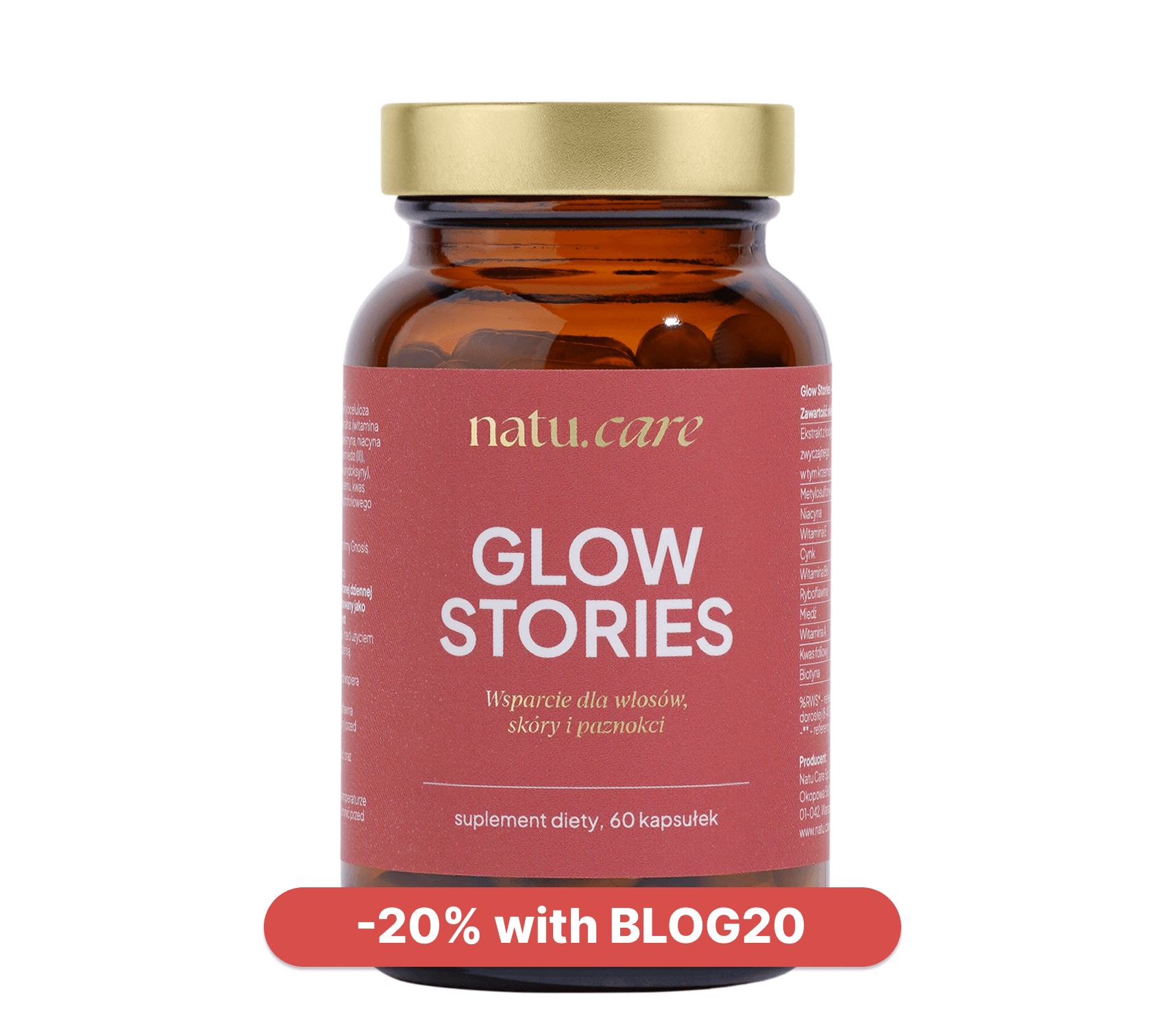
- Active ingredients: bamboo shoot extract, Quatrefolic®, L-Methionine, L-cysteine, vitamin E, vitamin A, niacin (vitamin B3), vitamin B6, vitamin B2 (riboflavin), biotin, zinc, copper
- .
- Form: capsules
- .
- Dose: 1 capsule per day
- .
- Sufficient for: 60 days
- .
Product description
A dietary supplement containing vitamins, minerals and plant extracts thatósupport the skinóhand, hair and nails. The product is especially distinguished by the form of folate – it is Quatrefolic, whichós absorbed very well and is natural.
In addition to valuable vitamins and minerals, such as vitamin A, E, B3, B2 and biotin, the formula contains bamboo shoot extract, whichóry further enhances your beauty.
Pros and cons
A dietary supplement containing vitamins, minerals and plant extracts thatósupport the skinóhand, hair and nails. The product is especially distinguished by the form of folate – it is Quatrefolic, whichós absorbed very well and is natural.
In addition to valuable vitamins and minerals, such as vitamin A, E, B3, B2 and biotin, the formula contains bamboo shoot extract, whichóry further enhances your beauty.
Additional information
A dietary supplement containing vitamins, minerals and plant extracts thatósupport the skinóhand, hair and nails. The product is especially distinguished by the form of folate – it is Quatrefolic, whichós absorbed very well and is natural.
In addition to valuable vitamins and minerals, such as vitamin A, E, B3, B2 and biotin, the formula contains bamboo shoot extract, whichóry further enhances your beauty.
Black and yellow statistics
.Bees in Poland
.About 80% of crop plants in Poland are pollinated by insects, and 90% of these insects are bees. Interestingly, thanks to these insects, even plants that use the wind for pollination produce more abundant crops. According to the Supreme Chamber of Control, bees earn for Polish agriculture between 4.1 and 4.7 billion zlotys a yearand.
.There are around 470 species of bees in Poland, but almost half of them are threatened with extinction . Fortunately, researchers have seen a steady increase in honeybee populations since 2011.
The Programme for the Conservation of Farm Animal Genetic Resources keeps statistics on bee colonies under protection. According to them, over the last decade (2013-2022), the population of protected bee colonies in Poland has increased by more than 27%and.
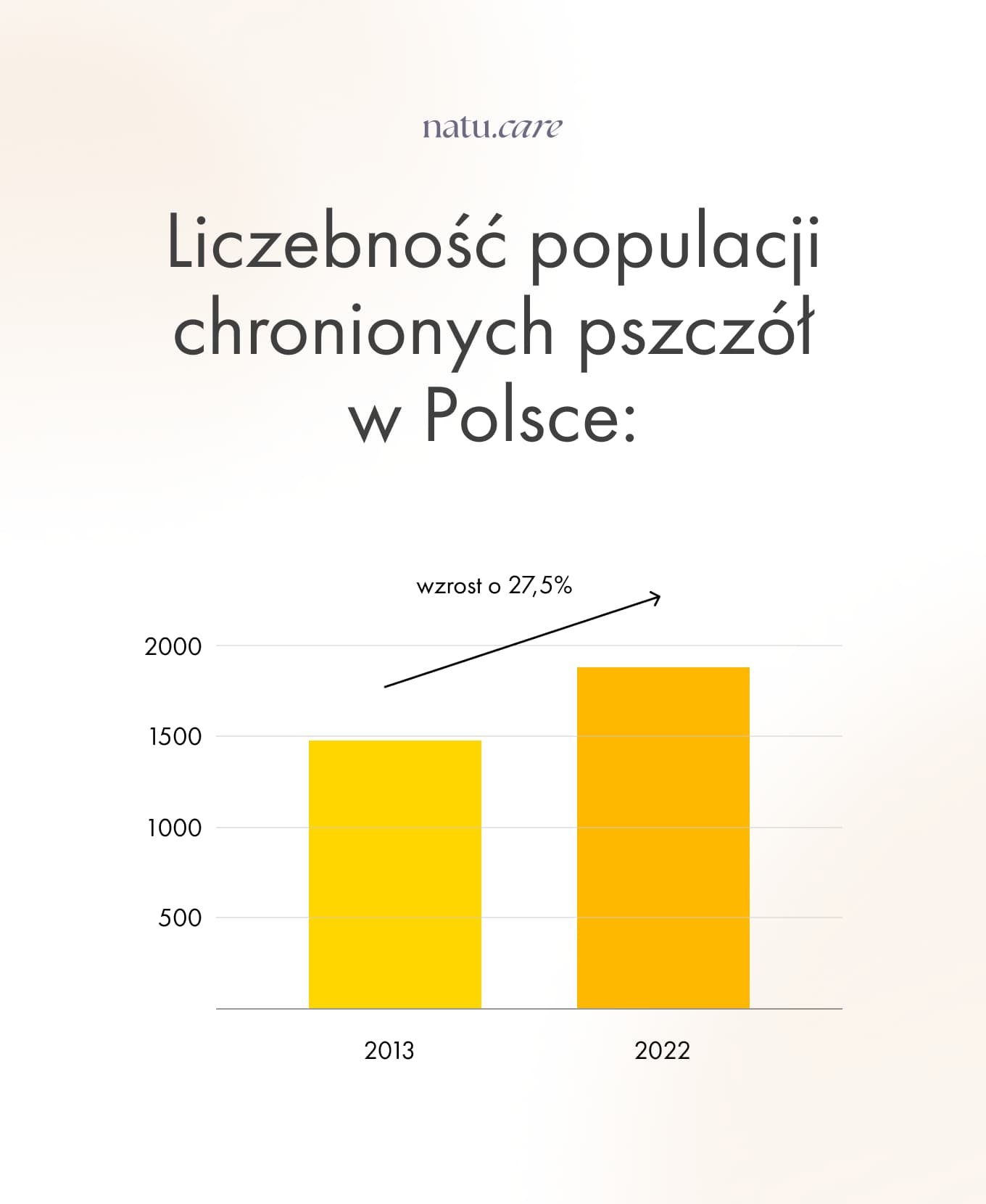
Also, data from the Veterinary Inspection records seem optimistic - in 2021, compared to 2020, the number of bee colonies in registered apiaries increased by 14% .
Does this mean that the future of Polish beekeeping is painted in rosy colours and we can sip the nectar of victory?
.Not necessarily. Firstly, according to data from the Beekeeping Department in Puławy the ratio of apiculture, i.e. the number of bee colonies per km², in 2021 averaged 6.4and. Experts indicate that it should be at least 8.
Levels of infestation are uneven. In some provinces, such as Małopolskie (12.5), Lubelskie (10.4) or Podkarpackie (9.8), there is over-sealing..
 .
.
Agneska Dukat-Pokrywa beekeeper from Apiary on the Shore
Another issue is that almost 30% of beekeepers in Poland are over 65and. Who will take over the care of the apiaries when they go into well-deserved bee retirement?"
.World bees
.The world's bee population has been in decline since the 1960s.

In the late 1980s, Europe faced a significant decline in bee populations. However, the situation is beginning to improve. According to the European Commission, there was a 6% increase in the number of hives in EU countries in 2021, compared to the previous yearand.
The largest number of bee colonies is in Spain, Romania and Greece. Poland ranks fourth in this ranking. So close to the podium...!
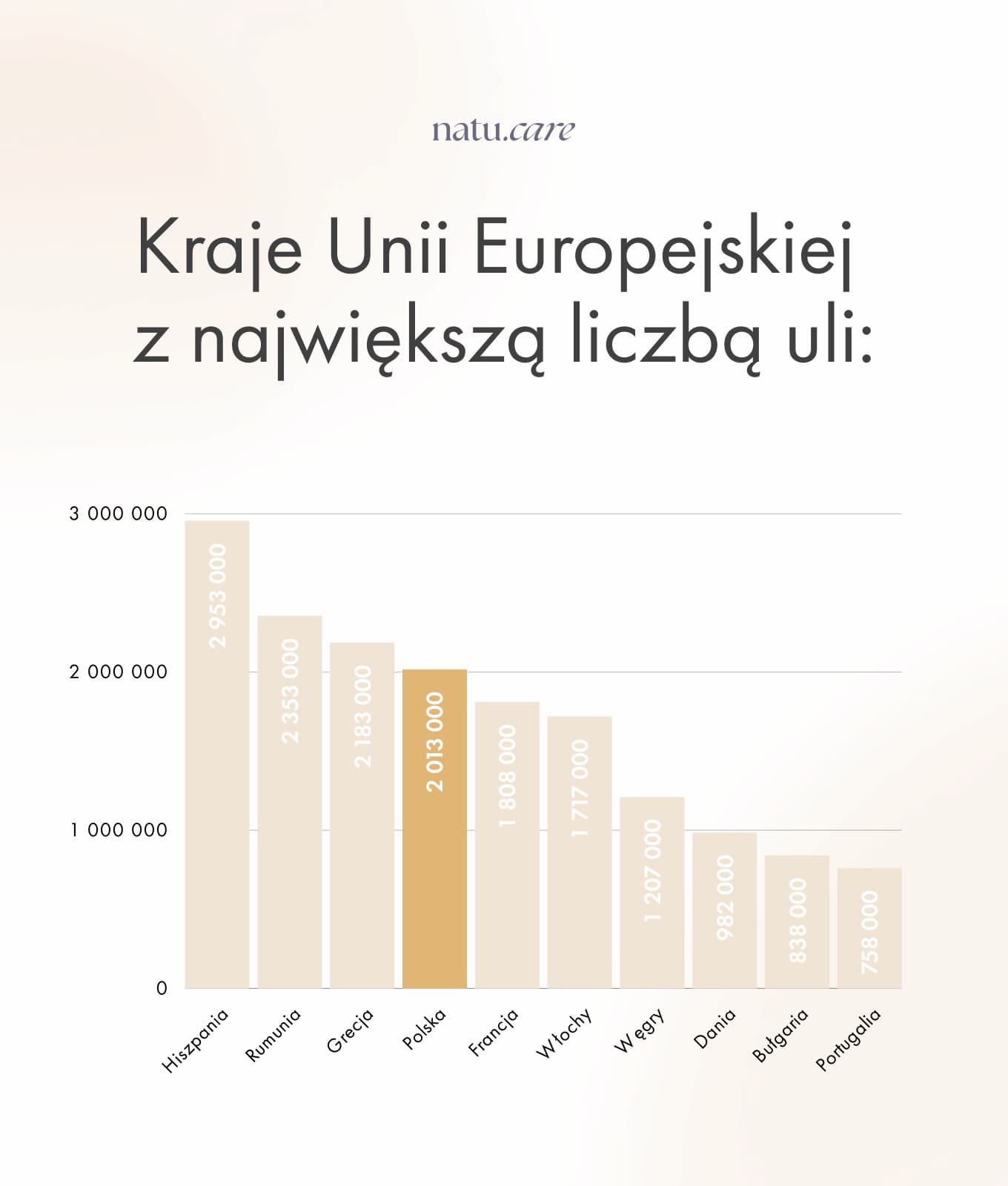
Once upon a time in America
.From time to time since the beginning of the 21st century, news of a massive bee die-off has been circulating in the American media. In 2018, it was reported that US beekeepers had lost 40% of their honeybeesand. This led to panic and fears of a mass bee die-off.
However, global data on the populations of these insects does not confirm the unrestand. Nor is it borne out by U.S. Department of Agriculture data showing that, compared to 2000-2009, the U.S. bee population grew by 7.7 percent between 2010 and 2020.
The U.S. bee population is also growing by 7.7 percent.
This does not mean, however, that bees in the United States are not under threat. Climate change is triggering an increasing number of natural disasters in the region, which could adversely affect local populations of these pollinators.
The climate is also changing.
Not insignificant is also the destruction of the bees' natural environment, with the consequent shortage of food and the invasion of mites - the plague of bees.
A world without bees, or emptiness on... the plate
.The cucumber season is underway. A time of sunshine, holidays, carefree and... a harvest of crunchy ground cucumbers. It's also the time when we pack them in the pickles with a view to winter. Without bees, we could easily call the cucumber season the empty jar season.
About 300,000 plant species depend on pollinators, and many of these are edible plants. Too few bees will deprive us not only of the pleasure of eating, but also of many essential sources of nutrients in our diet. After all, it is from vegetables and fruit that we get the most vitamins, micro and macronutrients.
What wouldn't you eat without bees?
.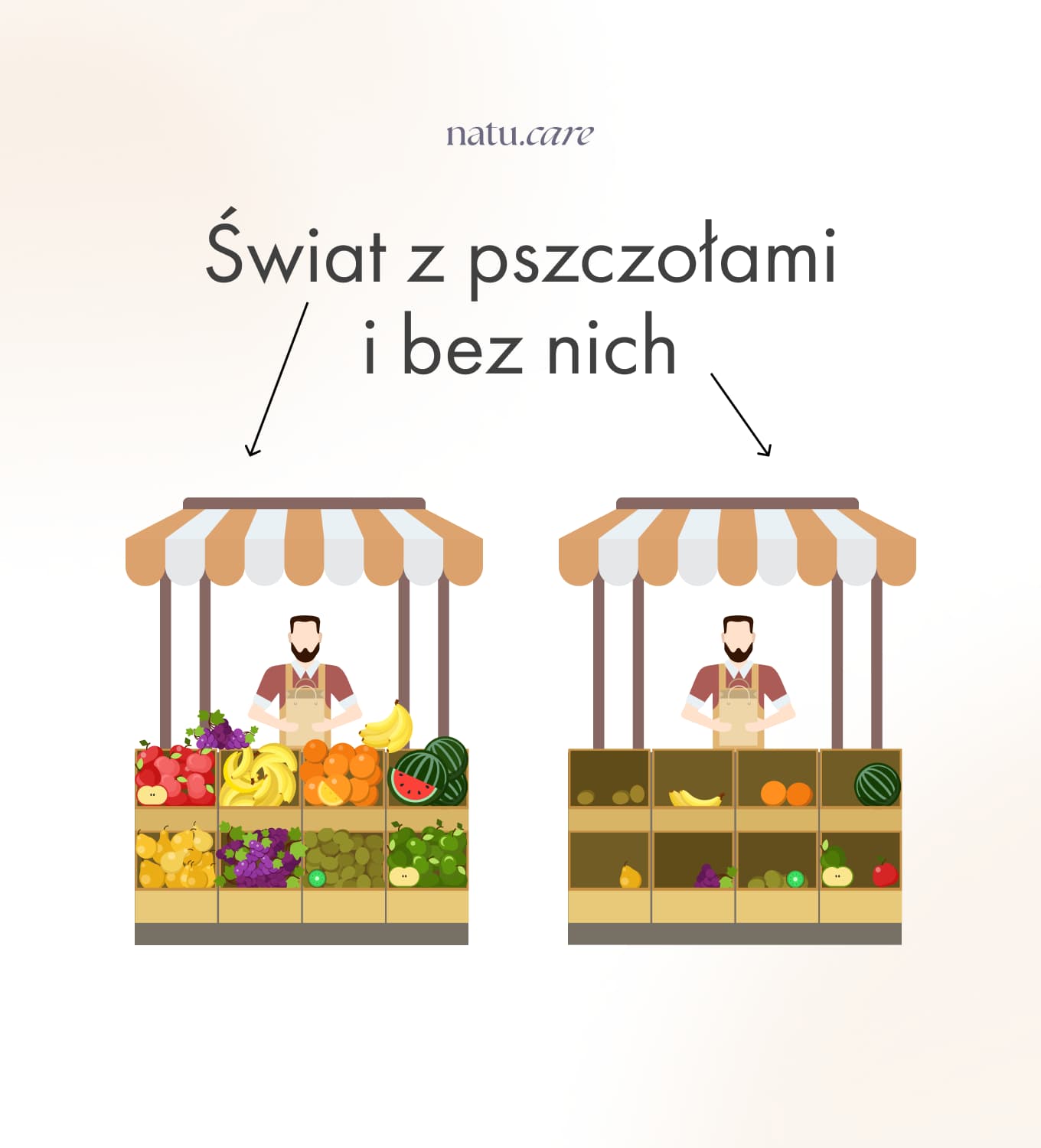
Vegetables
.Without bees you can forget about cucumbers, pumpkins and squash. Without pollination, they won't bear fruit, so there will be nothing to harvest. Some vegetables need bees to produce seeds, that is, to reproduce. Although we do not eat their fruit, but for example their tubers or inflorescences, they also do not survive without pollinators.
Such vegetables include, for example:
.- cauliflower, .
- carrots, .
- leek, .
- cabbage, .
- broccoli, .
- beet, .
There are also plants that use wind power for reproduction. However, bees effectively add the hard work of their wings to the process, making for a larger and better quality harvest. Although these plants would probably survive without pollinators, their numbers would decrease and prices would skyrocket.
This group of vegetables includes:
- tomatoes, .
- caps, .
- potatoes, .
- cbula, .
We would also have to say goodbye to many seeds, herbs and spices, such as sunflower seeds, mustard seeds and almonds.
Fruits
.What could be better on a hot summer day than a bowl of cold cherries straight from the fridge? Or pasta with strawberry sauce (Polish spaghetti)? It would be hard to think of a good substitute for these delicacies, and without bees we would be forced to do so.
Thanks to pollinators, we can still enjoy the taste of:
- apple, .
- currants, .
- strawberries, .
- leaves, .
- blueberries, .
- oranges, .
- arbons, .
- cherries, .
- kiwi, .
- agrest, .
- currants, .
In short, of the popular fruits we would practically only have bananas left. As with vegetables, even if some fruit plants are able to pollinate by wind, their yields would be much less abundant and the fruit smaller and often misshapen.
Interesting fact
.Without bees, coffee would become a luxury good. Although the coffee plant is self-pollinating, it needs pollinators to produce a healthy crop. Without this, the plant would be susceptible to disease and produce far fewer seeds. Think about this with your afternoon cappuccino.
Meat?!
.Yes, meat would also be crumbly in a world without bees. After all, these insects pollinate most forage crops, i.e. those on which cattle feed. Of course, cows wouldn't go extinct without clover or alfalfa, but farmers would be forced to replace them with something, which would increase farming costs.
>And you've probably already guessed what that would mean. Price increases. Not just meat, but also dairy products.
What is pollination
.So you can see that it is not honey that is bee gold, but the ability to pollinate. And what is it actually all about?"
.Seed plants, like most living organisms, need a combination of female and male reproductive cells to reproduce. But it's hard to go on a date when you've deeply planted roots in the ground. That's why male reproductive cells have evolved to form pollen, which is lightweight and easily transported.
Some seed plants use wind to transfer pollen to other flowers. Others depend on small, hairy helpers to collect nectar and spread the pollen directly to subsequent inflorescences. In this symbiosis, everyone wins: the bees do not go hungry and the plants can enjoy their offspring.
Interesting fact
.Bees fly at a speed of 20-30 kilometres per hour, but some sources say they can reach up to 60 km/h in favourable conditions.
Not just bees
.As many as 90% of pollinators living in Poland are honeybees, but we don't want to make the other 10% uncomfortable, so I will introduce them right away. The group of pollinating insects also includes:
.Bumblebees
.Bumblebees belong to the bee family and ask not to be called bumblebees. Bumblebees are biting bugs that resemble flies. Bumblebees, on the other hand, are fluffy, cute little balls and although they have a stinger, they sting even less frequently than bees. Seriously, have you heard of anyone being stung by a bumblebee?"
.Also, they are not intimidated by low temperatures (as low as 12°C), can work in a drizzle and do so for about 2-3 hours longer in a day than bees.
Garden mason bee
.It is also a bee, only of the species lone bees. Unlike its more famous cousin, the honeybee, all female mason bees establish their nests and raise their young independently.
The mason bee is also known as a "honeybee".
Although equipped with a stinger, the mason bee is unlikely to sting you - even in defence of its nest. It is smaller than the honeybee and slightly darker - its colouration is a reddish-brown.
Butterflies
However, they are not likely to sting you.
Butterflies
.These chaotically flying beauties also feed on flower nectar, so they also carry pollen. However, they are less efficient at this than bees, because most species do not have hairs on their bodies. And as you already know, hairs increase pollinator effectiveness because pollen attaches to them.
Pollinating insects also include moths, beetles and hoverflies..
 .
.
Agneska Dukat-Pokrywa beekeeper from Apiary on the Shore
What bees fear most - about the dangers
.If you ask bees, they would probably answer that they are most afraid of ending up in a bird's beak. However, the experts agree: the biggest threat to bees is man (with all his civilisation).
We are in danger.
Our development is taking away the bees' habitat, i.e. their natural habitat. We are replacing meadows with block housing and wild flowers with evenly trimmed lawn. Pollution and the spread of invasive species (i.e. species that shouldn't be in a particular region)and are also having a major impact on pollinator health and abundance.
We're not helping.
It also doesn't help that a warming climate affects the flowering periods of particular plants, which translates into food availability for insects. As the 2021 studyand showed, rising temperatures also have an impact on the sperm quality of male bees. And this clearly translates into bee colony numbers.
Additionally, plant protection products can also harm pollinators, especially if different preparations are applied simultaneously. Then, even if individual substances would not pose a threat, their mixtures may already be poisonousand.
What can you do for bees?
.You read: climate change, pesticides, concretosis and you're probably thinking to yourself, what can I do...? Fact, you have a negligible impact on global factors, but there are a few things that bees will thank you for.
On the balcony
.Instead of petunias and geraniums, you can sow honey plants in the boxes. These include, for example, cornflowers, geraniums (or boysenberries), sweet peas (it has beautiful flowers and is a fast-growing climber), catkins, catnip (something for cat people), clover, irises or heather. Personally, I can recommend yarrow - it is hardy even for gardening 'talents' like me.
.You can also make an insect drinker. All you need to do is to pour some water into the saucer from the pot and arrange the stones so that they partially protrude above the surface. Insects and small birds alike can benefit from such a watering hole.
.In the garden
.What if you didn't mow the grass so meticulously in every nook and cranny of the garden? Save yourself the work and leave a patch of land to go wild. You can also use ready-made wildflower meadow seed mixes, available from garden shops.
All fruit trees (apple, pear, plum) and fruit bushes such as blueberries will also be helpful for the bees. And the bees will eat, and so will you.
For the garden, make sure you do the same.
A drinker will also work well in the garden. You can place one on an elevated platform and the other on the ground - who knows, maybe a hedgehog will drink too.
A garden allotment waterer will also work well.
An allotment can instead be a great place for an insect house. You can make one yourself or buy a ready-made one (at most DIY stores).
The
Bee playlist
.If you want to attract more bees to your garden, play with a... DJ. Bees inform their companions about the best places to collect pollen and nectar by emitting sounds at 250-300 Hz. It just so happens that some songs have a similar frequency.
Here are 50 tracks to rock any bee party <move over to Spotify>.
In the city
.Many cities in Poland seem to have recognised the need to protect pollinating insects. Suffice it to mention that as many as 269 municipalities from all over Poland joined the Bee Friendly Municipalities Manifesto initiative in 2018.
>In some localities, roadside green belts are no longer mowed and field flowers are sown on them. In urban green areas, melliferous plants are planted.
>You too have a say in what happens in your town - thanks to citizen budgets. You can vote for the creation of wild meadows and new plantings of trees and other plants. It really does make a difference!
Buying honey in the market? How about supporting local apiaries? By buying certified honey from your local area, you are also acting for the good of the bees. And yours - such products are likely to be much healthier than the market offerings.
In the countryside
.Research confirms that the use of neonicotinoids, the substances used in some plant protection products (pesticides), is a deadly threat to beesand. And this is true even when they have been used in doses lower than recommended by the manufacturer.
If you want to help the bees, pay attention to the composition of the products you use to spray (whether for crops or ornamental plants in the garden).
See also:
Summary
.- There are approximately 470 species of bees in Poland. As many as 222 of these are threatened with extinction.
- .
- Bees are responsible for the pollination of approximately 80% of the cultivated plants in Poland.
- Bees are responsible for the pollination of approximately 80% of the cultivated plants in Poland.
- The bee family acts as a single, well-functioning organism in which each individual has well-defined roles.
- The bee population in Poland is increasing, but we still have not reached the optimal seeding rate.
- Without bees, we would lose most of the fruit and vegetables we eat every day.
- Without bees, we would lose most of the fruit and vegetables we eat every day.
- Pollinating insects also have an impact on meat and dairy production - many fodder crop species are pollinated by them.
- Bees are also a major contributor to the production of meat and dairy products.
- In addition to bees the group of pollinators includes bumblebees, garden wrens and butterflies.
- You can help pollinating insects by sowing and planting honey plants. .
FAQ
.How many flowers does a bee visit?
.During one flight from the hive (or nest), a honeybee visits approximately 50-100 flowers. To produce a kilogram of honey, as many as 4 million flower visits are required. One bee is able to produce a flat teaspoon of honey during its lifetime.
How long does a queen bee live?
.Mother queen bees live much longer than worker bees. On average, a worker bee lives only 5-6 weeks, while a queen bee lives to be about 5 years.
Why are bees beneficial?
.Bees are very useful insects. Not only do they provide us with a sweet treat in the form of honey, but most importantly they help pollinate plants - including crops. It is through pollination that bees have a huge impact on agriculture and thus food abundance.
What happens after the death of a queen bee?
.After the death of the queen bee, the worker bees breed new queens from young larvae. While alive, the queen-mother bee secretes special hormones that prevent other bees from reproducing.
The absence of these hormones after her death gives the hive the signal to breed new queens. One of them will replace the previous queen, the rest will die or fly away with part of the swarm to start a new bee colony.
How much does 1 hive of bees cost?
.The price of a hive depends on its size and type. Beekeeper Agnieszka Dukat-Pokrywa explains: prices for polystyrene hives range from £450 to £700, wooden ones start at £500. For a farmed, i.e. a small 5-frame bee colony you have to pay 300 zł. For a large, overwintered one around 550-800 zł.
.What type of honey is the healthiest?
.Honeydew honey, which is extracted from honeydew accumulated on trees, is considered to be the most valuable. Beekeepers emphasise the health-promoting and flavour-promoting qualities of coniferous honeydew honey in particular.
.A very valuable beekeeping product is also bees' wheather. It is a mixture of honey, pollen and... bees' saliva. It contains many vitamins and minerals. It can usually be purchased in the form of brown granules.
Is honey bee droppings?
No, but the bee digestive system has quite a lot in common with honey. It is there (specifically in the honey goitre) that the enzymes necessary to convert it into honey are attached to the flower nectar. The substance is then returned by the bee to the cells of the comb, where the honey matures.
.
Agneska Dukat-Pokrywa, beekeeper adds: maturation involves the evaporation of excess water. Mature honey must not contain more than 18% water (only heather honey contains 22% water). Too much water can lead to fermentation of the honey and spoilage.
Sources
.See all
.Blacquière, T., Smagghe, G., van Gestel, C. A. M., & Mommaerts, V. (2012). Neonicotinoids in bees: A review on concentrations, side-effects and risk assessment. Ecotoxicology, 21(4), 973-992. https://doi.org/10.1007/s10646-012-0863-x
De Jong, D., & Lester, P. J. (2023). The global challenge of improving bee protection and health. Frontiers in Bee Science, 1. https://www.frontiersin.org/articles/10.3389/frbee.2023.1118292
Honey Bees as Pollinators, Their Habitats and Products. (n.d.). Retrieved 20 July 2023, from https://extension.missouri.edu/publications/m403
How Honeybees Reproduce-PerfectBee. (n.d.). Retrieved 20 July 2023, from https://www.perfectbee.com/learn-about-bees/the-science-of-bees/how-honeybees-reproduce
How Neonicotinoids Can Kill Bees | Xerces Society. (n.d.). Retrieved 21 July 2023, from https://xerces.org/publications/scientific-reports/how-neonicotinoids-can-kill-bees
https://www.facebook.com/unep. (2019, May 20). Why bees are essential to people and planet. UNEP. http://www.unep.org/news-and-stories/story/why-bees-are-essential-people-and-planet
Hung, K.-L. J., Kingston, J. M., Albrecht, M., Holway, D. A., & Kohn, J. R. (2018). The worldwide importance of honey bees as pollinators in natural habitats. Proceedings of the Royal Society B: Biological Sciences, 285(1870), 20172140. https://doi.org/10.1098/rspb.2017.2140
Khalifa, S. A. M., Elshafiey, E. H., Shetaia, A. A., El-Wahed, A. A. A., Algethami, A. F., Musharraf, S. G., AlAjmi, M. F., Zhao, C., Masry, S. H. D., Abdel-Daim, M. M., Halabi, M. F., Kai, G., Al Naggar, Y., Bishr, M., Diab, M. A. M., & El-Seedi, H. R. (2021). Overview of Bee Pollination and Its Economic Value for Crop Production. Insects, 12(8), Article 8. https://doi.org/10.3390/insects12080688
Kobylinska, M. (2021a). Regional variation of beekeeping in Poland. Statistical News. The Polish Statistician, 66, 25-38. https://doi.org/10.5604/01.3001.0014.7388
.Kobylinska, M. (2021b). Regional differentiation of beekeeping in Poland. Statistical News. The Polish Statistician, 66(2). https://doi.org/10.5604/01.3001.0014.7388
Not only bees pollinate flowers! - WorldOZE.co.uk. (2018, August 10). https://swiatoze.pl/nie-tylko-pszczoly-zapylaja-kwiaty/
About Bees-Helping Bees. (n.d.). Retrieved 20 July 2023, from https://www.pomagamypszczolom.pl/o-pszczolach
Garden for the Bees. (2023, Jan 5). Wild pollinators. https://dzicyzapylacze.pl/ogrod-dla-pszczol/
Patel, V., Pauli, N., Biggs, E., Barbour, L., & Boruff, B. (2021). Why bees are critical for achieving sustainable development. Ambio, 50(1), 49-59. https://doi.org/10.1007/s13280-020-01333-9
Professor Talk: Honey from carrion and vulture bees, or the hologenome, evolution and amazing nature. (2018, January 11). Professor Talk. https://profesorskiegadanie.blogspot.com/2018/11/miod-z-padliny-i-pszczoy-sepy-czyli-o.html
Beekeeping, P. (n.d.). Plant pollination by honey bees. Retrieved 20 July 2023, from https://www.portalpszczelarski.pl/artykul/167/zapylanie_roslin_przez_pszczoly_miodne.html
Bees-Population numbers by year | Farm Animal Genetic Resources Conservation Programmes. (n.d.). Retrieved 21 July 2023, from http://www.bioroznorodnosc.izoo.krakow.pl/pszczoly/liczebnosc
The Colony and Its Organization. (n.d.). Mid-Atlantic Apiculture Research and Extension Consortium. Retrieved 20 July 2023, from https://canr.udel.edu/maarec/honey-bee-biology/the-colony-and-its-organization/
What Do Bees See? And How Do We Know? (2011, July 27). NC State News. https://news.ncsu.edu/2011/07/wms-what-bees-see/
Withdraw pesticides harmful to bees! (n.d.). Greenpeace Poland. Retrieved 21 July 2023, from https://www.greenpeace.org/poland/aktualnosci/888/wycofajmy-pestycydy-szkodliwe-dla-pszczol/
Zhao, H., Mashilingi, S. K., Liu, Y., & An, J. (2021). Factors Influencing the Reproductive Ability of Male Bees: Current Knowledge and Further Directions. Insects, 12(6), Article 6. https://doi.org/10.3390/insects12060529
Biodiversity Business Report https://backend.pomagamypszczolom.pl/media/attachments/RAPORT_Biznes_na_rzecz_bioroznorodnosci_MALY.pdf
Report 3rd edition of the Bee Friendly Communities Manifesto https://backend.pomagamypszczolom.pl/media/attachments/raport2019_SELzU07.pdf
Institute of Horticulture - PIB Department of Beekeeping in Puławy The beekeeping sector in Poland in 2021 http://www.inhort.pl/wp-content/uploads/2022/07/Sektor-pszczelarski-w-Polsce-w-2021-roku.pdf
Bee statistics and key facts you need to know in 2023! (2023, February 3). https://worldanimalfoundation.org/advocate/bee-statistics/
Osterman, J., Aizen, M. A., Biesmeijer, J. C., Bosch, J., Howlett, B. G., Inouye, D. W., Jung, C., Martins, D. J., Medel, R., Pauw, A., Seymour, C. L., & Paxton, R. J. (2021). Global trends in the number and diversity of managed pollinator species. Agriculture, Ecosystems & Environment, 322, 107653. https://doi.org/10.1016/j.agee.2021.107653
Honey Market Overview (Spring 2023). (2023, April 21). https://agriculture.ec.europa.eu/farming/animal-products/honey_pl
Editorials
Meet the team

Beekeeper
Agnieszka Dukat-Pokrywa is the owner of the agro-tourism farm Pasieka na Brzegu. There she keeps bees, grows blueberries and a pollinator-friendly garden. She also runs beekeeping workshops for children and adults, and welcomes guests in a cosy flat. She is enthusiastic about nature and its beneficial effects on humans.


World Water Day aims to raise awareness of the lack of drinking water in many regions of the world.

How many Poles are single and why have they chosen to live alone?

World Cancer Day encourages research and healthy lifestyles.



